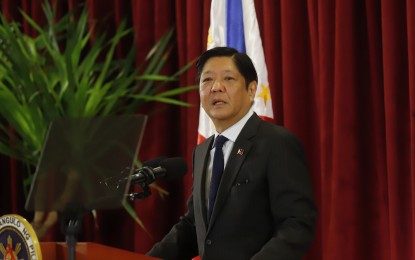
President Ferdinand R. Marcos Jr. (PNA file photo)
MANILA – President Ferdinand R. Marcos Jr. wants a whole-of-government approach and the institution of protocol-based and scientific long-term processes that will address the El Niño phenomenon, projected to hit the country until early 2024.
Quoting Office of Civil Defense (OCD) Administrator Undersecretary Ariel Nepomuceno during a press briefing in Malacañang on Tuesday, the Presidential Communications Office (PCO) said the President, during a multi-sectoral meeting earlier in the day, tasked several government agencies to implement a public awareness campaign that will educate people how to conserve water and energy, among others, to help address the impact of the dry spell.
“Nagbigay po kanina ng malinaw na instructions or utos ang Pangulong Bongbong Marcos na palaksin pa ho natin iyong paghahanda doon sa inaasahang masamang epekto ng El Niño (The President issued clear instructions or directive to strengthen the preparations against the expected negative impact of El Niño),” he said.
Nepomuceno said the water supply problem is widely expected due to the dry spell, thus, the President directed public institutions like schools to conserve water before the problem further intensifies.
He said Marcos also wants power conservation measures to be in place to limit the impact of El Niño.
He explained that through the mechanisms of the National Disaster Risk Reduction and Management Council (NDRRMC), the President wants the immediate establishment of an El Niño team that could effectively respond to the crisis.
The meeting was attended by heads of the Department of National Defense (DND), Department of Energy (DOE), Department of Environment and Natural Resources (DENR), Department of Science and Technology (DOST), National Disaster Risk Reduction and Management Council (NCRRMC), Department of Agriculture (DA), Department of Health (DOH), National Irrigation Administration (NIA), National Water Resources Board (NWRB), and the Metropolitan Waterworks and Sewerage Systems (MWSS).
During the same briefing, Department of Science and Technology-Philippine Atmospheric, Geophysical, and Astronomical Administration (DOST-PAGASA) Deputy Administrator Esperanza Cayanan said latest forecast shows an 80 percent probability of the occurrence of El Niño from June to August this year.
She said from November to December 2023 until January 2024, the weather bureau’s forecast is an 86 percent probability of El Niño.
“Bago pa natin maramdaman iyong epekto nitong El Niño, which is less amount of rainfall in most areas of the country, mayroon pa po tayong tag-ulan (We still have the rainy season before we experience the effect of El Niño),” she added.
Relatively, NIA Acting chief Eduardo Guillen said they have formulated short-, medium-, and long-term solutions to the looming drought.
He said they have what they call a cropping calendar wherein they plan which areas will be prioritized, especially the areas where rice is being planted and are near the water sources.
“In close coordination po dito sa DA para mabawi natin iyong kakulangan doon sa ating area na matataniman kapag dry season. Magko-concentrate po kami sa hybrid, hybrid rice, kasi talagang times two po iyong output nito pag dry season (This is in close coordination with the DA so that we can address the deficiency in areas where we can plant during the dry season. We will concentrate on hybrid rice because the output is two times during the dry season),” he said.
Relatively, he said they have advised farmers whose areas are located far from water sources to plant high-value crops.
“Ang gusto ng Pangulo natin po ay maiparating sa ating mga farmers iyong tama at napapanahon na assistance kasi like in the case of hybrid rice alam po naman natin na mahal iyong inputs dyan (The President wants that correct and up-to-date assistance are given to farmers because in the case of hybrid rice we know that farm inputs are expensive),” he said.
Meanwhile, Guillen said the President wants efforts of NIA and the Local Water Utilities Administration (LWUA) to be merged as a long-term solution to address challenges in managing water resources, especially during the rainy season.
He said among the options cited during the meeting include an increase in NIA’s budget and tie-up with other agencies such as the Department of Public Works and Highways (DPWH) for a paradigm shift for flood control to water management.
“Ang pinakamabisa po kasi na flood control project is water management (The most effective flood control project is water management,” he said, citing that this include the construction of impounding dams and small river impounding projects.
He said NIA may also look into the possibility of construction of high dams.
Last February, the President approved the creation of a Water Resource Management Office (WRMO) to manage water resources in the country and respond to the current environmental challenges.
The WRMO will be under the DENR and will serve as a transitory body prior to the creation of the Department of Water Resources. (PNA)
